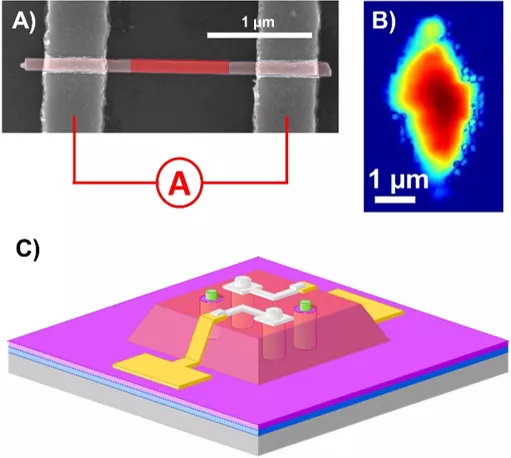PhD project: Photon detection & sustainable energy
Advanced nanostructures for photon detection and sustainable energy generation
Solar cells and photodetectors absorb photons and convert their energy into electrical power, and they are essential for renewable energy generation, telecommunications and X-ray imaging. Completely new optical and electronic semiconductors properties can be achieved by nanostructuring. For instance, quantum confinement can make the optical absorption strongly size dependent, and new crystal structures, that are unstable in bulk, can be created. This project will use state of the art nanofabrication methods to create novel devices that convert photons to electrical current. The student will develop devices and study their interaction with photons. In particular, the project will study nanostructures of lead halide perovskites, a novel class of materials which shows very promising performance in solar cells and X-ray detection. The devices will be characterized and optimized using electrical and optical methods. The nanostructures will also be investigated using X-ray methods at the new MAX IV synchrotron in Lund, as well as at PETRA-III in Germany, ESRF in France and other international synchrotron facilities.
Introduction
The Department of Physics is, with a staff of about 350 scientists and educators, one of the largest departments within Lund University. There are seven research divisions and a number of research centra within the department. The research activities at the department cover a broad spectrum of modern physics. www.fysik.lu.se/english
The Division of Synchrotron Radiation Research is a part of the Department of Physics and has more than 40 employees. The focus of the research is on experimental studies of electronic, structural, and chemical properties of materials. The Division is developing a new activity focussing on magnetic properties. At the Division we use and develop a wide range of large facility- and lab-based techniques. We are additionally engaged in the development of the MAX IV Laboratory in the fields of beamlines, experimental stations, techniques for Synchrotron radiation and the accelerator systems. MAX IV is a national large-scale research laboratory hosted by Lund University and situated within biking distance from the Department of Physics. It provides scientists from Sweden and the rest of the world with the most brilliant Synchrotron radiation source and instrumentation for research in areas such as materials science, structural biology, chemistry and nanotechnology.
Website of the Division of Synchrotron Radiation Research
Website of MAX IV
See Jesper Wallentin's page for information about the main supervisor of the project
Project specification
Work duties
Solar cells and photodetectors absorb photons and convert their energy into electrical power, and they are essential for renewable energy generation, telecommunications and X-ray imaging. Their performance is limited by the semiconductor materials that they are formed of, but completely new optical and electronic semiconductors properties can be achieved by nanostructuring. For instance, quantum confinement can make the optical absorption strongly size dependent, and new crystal structures, that are unstable in bulk, can be created. Nanostructuring can therefore allow radically new device concepts.
This project will use state of the art nanofabrication methods to create novel devices that convert photons to electrical current. The student will develop devices and study their interaction with photons. In particular, the project will study nanostructures of lead halide perovskites, a novel class of materials which shows very promising performance in solar cells and X-ray detection.
The student will create devices in the Lund Nano Lab, which has world class facilities for nanodevice fabrication. Devices will be made using electron beam lithography, crystal growth, metal evaporation and other nanofabrication tools. The devices will be characterized and optimized using electrical and optical methods. The nanostructures will also be investigated using X-ray methods at the new MAX IV synchrotron in Lund, as well as at PETRA-III in Germany, ESRF in France and other international synchrotron facilities.
More information about the Lund Nano Lab facilities
The project is primarily experimental and will require extensive work in the cleanroom of the Lund Nano Lab. Knowledge and experience of X-rays is not required; this will form a part of the training as required.
The main duties of doctoral students are to devote themselves to their research studies which includes participating in research projects and third cycle courses. The work duties can also include teaching and other departmental duties (no more than 20%).
Desirable skills
For the present position, competence in semiconductor physics and related experimental methods are of special value.
Additional assessment criteria are:
- Experience in semiconductor fabrication techniques such as lithography
- Experience in semiconductor physics
- Experience in optical and electrical characterization of semiconductors.
- Experience with novel materials, such perovskites or nanowires.
- Experience in crystal growth
- Experience in X-ray sources, X-ray detectors and X-ray imaging
- Experience in programming
Enrolment: Physics, Science Faculty
Supervisor
Homepage of Jesper Wallentin, Associate Prof. at the Div. of Synchrotron Radiation Research
Positions in the 1st call
The call was open from 23 March until 4 May 2020. Of the ten PhD students that were successfully recruited in this call, eight are eligible for GenerationNano funding.
- Smart nanomaterials for green-tech applications
- Characterization of nanostructured magnetic materials
- PhD project on information as fuel
- Photon detection & sustainable energy
- Ultrafast spectroscopy for new solar energy solutions
- Biomarker detection by optical sensing with nanowires
- Morphology and virulence among bacteria
- Multiscale biomechanics from molecules to cells in cancer
- Solubility of amyloid beta peptide (up to two positions)
- Nanoparticles in the brain: multitalented drug carriers to target neurodegenerative disease


